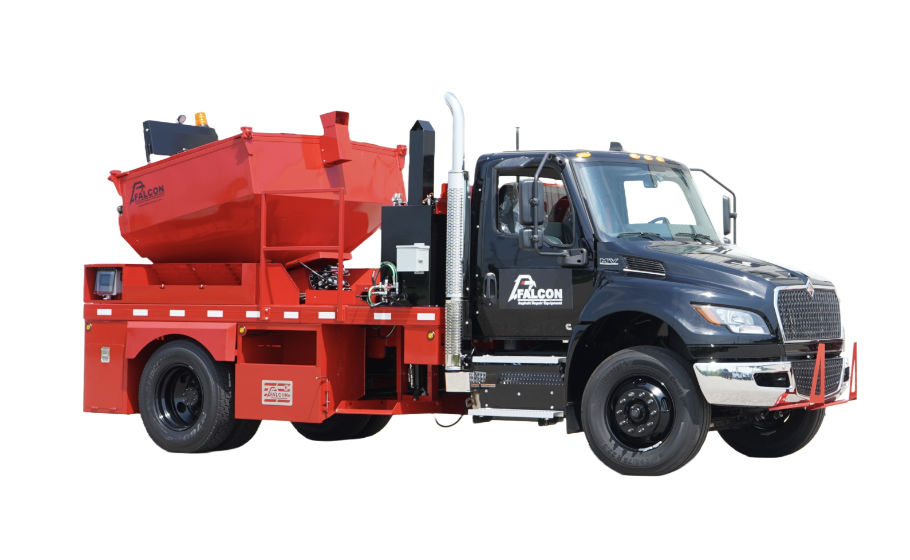Spec’ing a patch truck isn’t just about checking boxes. It’s about building a fleet that works as hard as your team does.
Tight alleyways, unpredictable weather, staffing shortages, and long days in the field—road maintenance crews face real challenges that demand equipment built to keep up. When you’re choosing your next patch truck, every spec—capacity, CDL requirements, delivery system design, and more—should help your crew stay productive and your roads stay safe.
In this guide, we break down how to spec a patch truck that aligns with your crew size, patching volume, and operational goals. Whether you’re replacing aging equipment or expanding your fleet, these steps will help you make a confident, cost-effective decision.
1. Define Your Operational Scope
Before comparing specs, step back and assess your day-to-day needs:
- How many road miles do you maintain?
- What’s your average patching volume per shift?
- Do you patch year-round, seasonally, or only after utility cuts?
- Do you have access to CDL-licensed drivers?
These answers will directly influence which truck size and configuration makes the most sense for your team.
2. Choose the Right Truck Capacity for the Job
Truck capacity affects everything from driver licensing and fuel economy to daily productivity. Falcon offers 2-ton, 4-ton, 6-ton, and 8-ton models, each engineered for different environments:
2-Ton Patch Truck
- Ideal for small municipalities or areas with narrow streets
- Doesn’t typically require a CDL
- Compact and maneuverable for tight urban environments
4-Ton Patch Truck
- Falcon’s most popular model
- Strikes a balance between capacity and flexibility
- Falls under the 26,000 lb GVWR limit—CDL typically not required
- Hopper holds up to 4 tons and retains heat with Falcon’s triple-wall air-jacketed insulation
6-Ton Patch Truck
- Designed for higher-volume repairs in larger cities or counties
- Requires CDL (GVWR of 35,000 lbs)
- Carries more asphalt and includes redundant hydraulic systems and a PTO-driven dump box for reliability
8-Ton Patch Truck
- Best for contractors or agencies repairing large networks daily
- Offers the highest efficiency and capacity for teams working long shifts
- Great for crews repairing multiple large areas in a give shift
PRO TIP: A bigger truck doesn’t always equal better. Oversizing can create budget waste or CDL bottlenecks. Undersizing can slow down crews with constant reloads.
3. Gravity Delivery: Why It Matters
Falcon’s Patch Trucks use a gravity-fed delivery system, a major shift from traditional auger or conveyor-based trucks. Asphalt flows naturally from the hopper and is controlled by an adjustable unloading door, giving crews the ability to meter material precisely without relying on mechanical conveyors or augers.
Advantages of Falcon’s Gravity Feed:
- Fewer moving parts = fewer failure points: No augers or belts means less maintenance and a lower risk of breakdowns.
- Efficient, fast unloading: Material flows at the speed your crew needs, helping them stay productive without delay.
- User-friendly operation: Simple controls reduce training time, which is ideal for crews with rotating or seasonal staff.
And because Falcon’s hopper features the largest unloading door in the industry, you get full control over asphalt delivery at job sites—be it a quick utility patch or a full-day route.
4. CDL Licensing and Driver Availability
One of the first, and most important, decisions when spec’ing a patch truck is choosing between a CDL vs. non-CDL configuration, based on your crew’s licensing, staffing flexibility, and daily workload needs.
Falcon’s 2- and 4-ton patch trucks fall below the 26,000 lb CDL threshold in most states, allowing them to be operated by anyone with a standard driver’s license. This broadens your labor pool and simplifies staffing.
Spec considerations:
- If you want to avoid CDL staffing limitations, spec a 2- or 4-ton model
- If you need more material capacity and already employ CDL drivers, consider a 6- or 8-ton model
Your decision here will affect not just how you spec your patch truck, but also how easily you can deploy crews, respond to emergency repairs, and manage compliance.
PRO TIP: If your team is often short on CDL operators or you want to cross-train more staff to drive, non-CDL models offer a reliable, scalable solution.
5. Look for Uptime-Enhancing Features
Every hour your truck is down is an hour your roads aren’t getting repaired. Falcon prioritizes uptime through smart engineering.
- Smart Control Digital Temperature Controller – Auto re-ignites when the temperature drops 10°F below the set point. Touchscreen interface with 7-day timer, fuel gauge, voltmeter, diagnostics, and more.
- Heated Triple-Wall Hopper and Apron – Air-jacketed system retains heat efficiently, even in winter. Insulated with 2″ mineral wool rated for 2,000°F combustion.
- Hydraulic Dump System – PTO-powered with dual 3″ hydraulic cylinders for redundancy. Heated, articulated chute for easy flow and safe positioning.
These features work together to minimize downtime and extend the life of every patch.
6. Why Hopper Design Matters
Falcon’s hoppers are more than insulated—they’re built for high-performance asphalt delivery:
- Seamless, triple-wall steel construction
- Heated walls + floor for consistent material flow
- Heat duct welded into hopper design to evenly distribute heat
- Heated worktable at the rear simplifies shoveling and cleanup
This design keeps asphalt at the right temperature and ensures crews can work efficiently, making hopper construction a key factor when spec’ing your next patch truck.
7. Match Special Features to Your Crew’s Needs
No two patch crews operate the same. Falcon offers modular, bolt-on options that make customization simple now or in the future.
Available add-ons:
- 50-gallon tack tank with spray system and hose reel
- Wash-down system for tools and truck
- Rear compactor basket (compatible with Bomag BVP 18/45-2w)
- Modular toolboxes, backup camera, night work lights, and more
Whether you’re patching utility cuts, potholes, or bridge decks, these options help make every job safer and more efficient, and can be added up front or down the line as your needs evolve.
Need something else specific to your operation? Give us a call and we can come up with a solution for your operation!
8. Warranty and Post-Purchase Support
Falcon’s support doesn’t stop at delivery. Every patch truck comes backed by a comprehensive ownership experience centered on helping you get the most out of your investment.
Included with every truck:
- 2-Year comprehensive machine warranty
- 5-Year maintenance-free ceramic combustion chamber
- On-site startup training from a Falcon-certified technician
- Operator, service, and parts manuals—provided in print and available online
In addition to support materials, Falcon’s in-house team is available to answer operational or technical questions throughout the life of the machine. If you’re troubleshooting in the field or training new staff, help is only a call away.
When you factor in long-term performance, fewer maintenance issues, and reliable post-sale support, Falcon’s Patch Trucks deliver more than just a dependable machine—they help you get the most value from your upfront cost. And if you’re budgeting for a new unit, it’s worth understanding what impacts patch truck pricing.
How to Spec Your Next Patch Truck with Confidence
If you’re determining how to spec your next patch truck, start by aligning the specifications with your crew’s operational realities—capacity, CDL requirements, uptime-critical features, and add-ons that support your operation.
At Falcon, we make it easy to spec the right patch truck with confidence. From 2-ton to 8-ton models, our trucks combine industry-first design features with intuitive tech like Smart Control and gravity-fed delivery—so your team can work safer, faster, and more cost-effectively every day.



Recent Comments